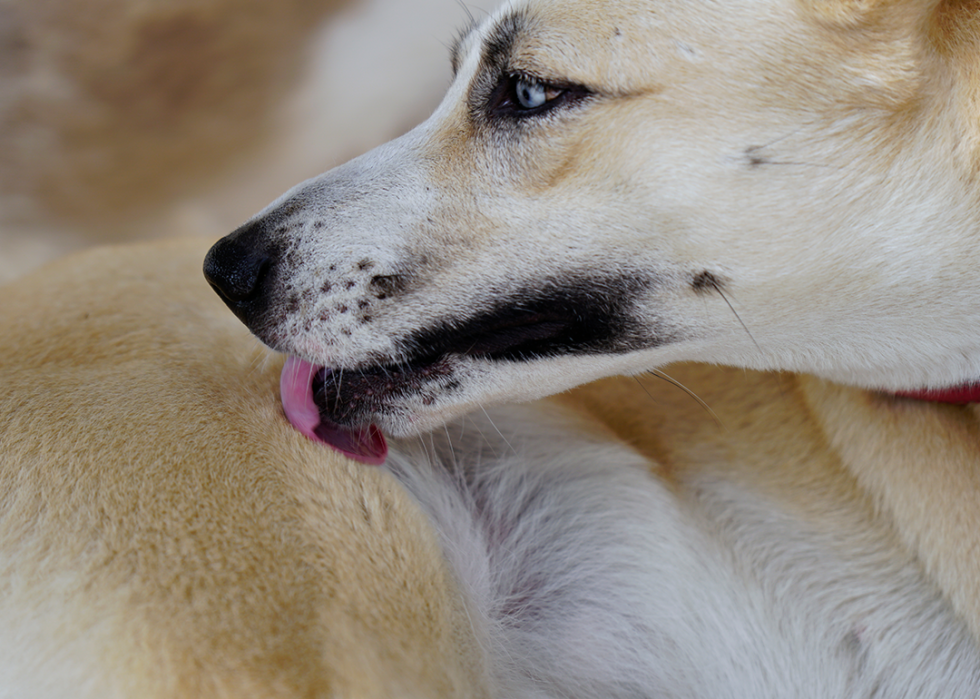
This story originally appeared on Ollie (Inc) and was produced and distributed in partnership with Stacker Studio.
Myths about dog wellness, debunked
A healthy pup means a happy companion for years to come, but it isn't always clear what guidance to follow regarding canine health. Even the widely held belief that dogs see in black and white has been disproven: They, in fact, see in a range of blue and yellow. Other things, like tail docking, evolved from the Roman times with the intent to protect dogs from disease and injury, but in the modern world, the practice is considered mutilation without an underlying medical necessity in locales including the U.K., Australia, and two U.S. states.
Other assertions can take on a life of their own despite lacking a factual basis. For example, grain-free dog food represented about 44% of the North American pet food market in 2020, yet gluten intolerance is extremely rare in dogs, and grains are, in fact, highly nutritious and beneficial for their diets.
In any case, a dog's veterinarian who knows its history is its best resource for guidance regarding its health, as the best strategies for canine wellness are highly variable depending on its breed, age, and unique needs. For less urgent information, consult articles citing reputable sources such as veterinary organizations or peer-reviewed studies.
To discern more fact from fiction in dog wellness, Ollie (Inc), a fresh dog food brand, debunked five common myths using research studies and news articles from the American Kennel Club and the American Animal Hospital Association.

Dogs eat grass when they feel unwell
The idea that dogs eat grass to soothe an upset tummy or make themselves throw up has been regurgitated more than chewed-up grass itself. A research study published in 2010 in the journal Applied Animal Behaviour Science found that dogs were actually less likely to consume grass when experiencing gastrointestinal upset. This makes more sense, considering dogs cannot digest grass and thus would not benefit much from its ingestion.
Experts at VCA Animal Hospitals have theorized that dogs eat grass because they are curious, hungry, bored, or seeking attention from their owner—in other words, it is normal behavior. Wolf scat analyses have found grass in significant amounts, suggesting foraging for plant material is consistent with instinctive behavior.

Dogs have bad breath
Considering how many foul-smelling things dogs are willing to put in their mouths, it is not necessarily surprising when Fido's kisses are a little less tolerable than usual. Persistent bad breath can be a sign of underlying health issues, according to the AKC. Interestingly, dog saliva is more alkaline than human saliva, making it less hospitable to bad-smelling bacteria.
Just like humans, poor oral hygiene is the leading culprit of bad breath and can be mitigated by increasing brushing. Accompanied by symptoms like changes in appetite or excretion, though, bad breath may also signify liver or kidney disease.

Dogs lick themselves frequently to groom
Dogs do groom themselves by licking, but excessive licking is often a sign of skin irritation or discomfort, which can have an array of causes and lead to bigger problems. Dogs are instinctively motivated to lick irritated spots and wounds to clear them of potential pathogens and promote healing. While their saliva does contain healing properties, the action presents a high chance of transmitting bacteria into the wound—so licking is generally not recommended as a treatment regimen.
Absent of any obvious causes of skin distress, such as redness or fleas, allergies may be the culprit of excessive licking. According to the AAHA, about 1 in 10 dogs have skin allergies, the most common allergic reaction in dogs.

Dogs are carnivores
Dogs do fall under the order Carnivora, but that does not mean they exclusively eat meat; even pandas, which eat bamboo almost exclusively, are technically carnivores using that criterion.
It is true, however, that their dietary habits derive from their ancestral roots—and wolves eat plenty of plant material too. One major distinction between the digestive systems of wolves and dogs is that dogs can produce amylase, which is used to break down grains in the digestive system. Furthermore, according to the AAHA, meat- and grain-based ingredients are equally digestible by dogs.

1 dog year is equivalent to 7 human years
It is one of the sadder facts of life that dogs have much shorter life spans than their owners, but it is not quite as simple as one year for every seven human years. The start of this aphorism is uncertain, but it likely originated during a time when the average human lived to be around 70 years old and the average dog was 10 years old.
In fact, the presumed life span of a dog varies significantly depending on its breed and size and is a bit more complex than multiplying by seven. According to the AAHA, a dog's first full year of life is akin to the developmental state of a 15-year-old human. The second year adds about nine human years. From there, the aging pace changes by size, with smaller dogs vastly outliving larger dogs. Regardless, quality time always trumps quantity of time—so maybe make that extra trip to the dog park.
Story editing by Carren Jao. Copy editing by Paris Close.



